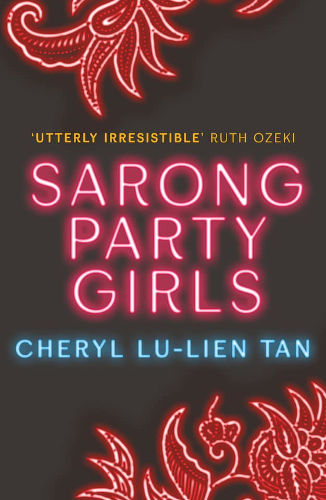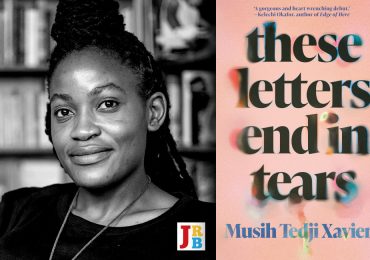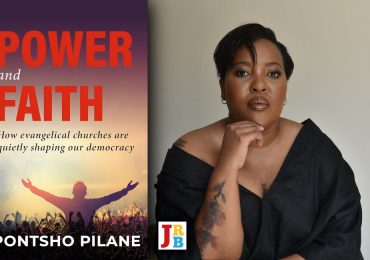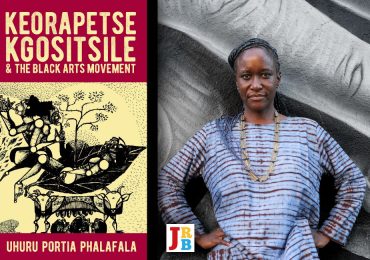As part of our January Conversation Issue, The JRB Publisher Ben Williams chats to Cheryl Lu-Lien Tan about her debut novel Sarong Party Girls.
‘Utterly irresistible. I fell in love with the fresh, exuberant voice and trenchant wit of Jazzy … In her debut novel, Tan is saying something profound and insightful about the place of women in our globalised, capitalised, interconnected world.’—Ruth Ozeki

Sarong Party Girls
Cheryl Lu-Lien Tan
Allen & Unwin, 2019
Ben Williams: Thanks for such a highly enjoyable and thought-provoking book, which stands out, among many other reasons, for being written entirely in Singaporean English, or Singlish. What gave the initial spark for the voice of the main character—an ambitious, assertive young woman named Jazzy—in your imagination?
Cheryl Lu-Lien Tan: It’s a book I’ve probably had in the back of my mind for years. I’ve always found SPGs [Sarong Party Girls—ed’s note] and the culture around SPGs completely fascinating—this little subculture in Singapore, to me, says something significant about the country and the sexual and racial politics of the place. Why is it that there exists a certain type of woman who sees status and material value in having a Caucasian husband or boyfriend? What are the forces of our history—colonial or otherwise—that have shaped this desire and belief in the value of Caucasian-ness? Seeing SPGs and SPG bars in Singapore always made me ponder these questions, so when it came to writing my first novel, this very Singaporean character that had always fascinated me came to mind.
I had actually thought I would write SPG as a nonfiction book but when I sat down to write a book proposal, it wasn’t flowing as smoothly as I liked. After a few frustrating days, I decided to sit down and tackle this topic via fiction, and Jazzy’s voice came to me right away. I wrote the first chapter in a day, pretty much. I find Jazzy endlessly fascinating because she’s such a product of society—you can really see how the forces of Singapore’s often patriarchal society have shaped her and continue to shape her in the book. She’s also a complex combination—smart, brassy, ambitious, vulgar, direct but also sweet, genuine and loyal to a fault. She’s very Singaporean in one fundamental way—she cannot lose! Singaporeans always say that our biggest defining trait as a people is that we are ‘kiasu’—a Hokkien or Singlish term that means ‘afraid to lose’. And Jazzy is definitely kiasu—she is so determined not to lose that she will do all she can to win.
Also, I chose to write the novel in Singlish because that’s what Jazzy would have spoken—it would have made no sense to have her speak proper Queen’s English or American English. That would have rung so false this book would not have any authenticity whatsoever.
I’ve long loved Singlish, too—there’s so much about it to love. And this novel is in a way my love letter to Singlish. I’ve always felt that it’s quintessentially Singaporean and so closely tied to our national identity—it’s direct, a little bossy, funny, sarcastic, witty and cheekily vulgar. Also, there was really no way to tell this story as vividly without telling it in Singlish. This patois is so much a part of Jazzy’s character as well as the rich tapestry of Singapore and its culture and the rhythm of its everyday life. I really wanted to share this intimate part of Singapore that I so love.
Ben Williams: The portrait Sarong Party Girls paints of Singapore is, while deeply human, not exactly flattering—particularly with respect to its society’s treatment of women. How has the book been received in Singapore? And by your Singaporean women friends? And by your family?
Cheryl Lu-Lien Tan: I wasn’t sure how the book would be received in Singapore, particularly because it’s not an entirely flattering portrait of a segment of society. My father was the first person in my family to read the book and I still remember, right after I gave him a galley of the book, he summoned me to lunch and asked me, crossly, ‘Who taught you to speak like that?’ I suppose it was terribly déclassé to have a daughter speak so coarsely in a novel—even if it was fiction! But he’s hugely supportive and once he got that out of the way he was all for the novel. The book actually ended up setting a record for the number of weeks a Singaporean author has spent on the bestseller list (at the time, twenty-eight weeks) so once that happened my dad and family were super proud. Never mind that my heroine was super smutty mouthed about everything!
As for my friends, well, some of the characters in the book are composites of people I know, it’s true—but they’ve not said very much about it to me. The research for this book all came about very organically, actually. When I was in Singapore researching A Tiger in the Kitchen, I reconnected with many childhood friends, some of whom were recently divorced and had started hitting the bars and clubs again. The more time I spent with these women at these clubs, the more interesting characters and vignettes I kept coming across. It wasn’t intentional but when I sat down to write SPG, these little backdrops and scenes all formed the tapestry that ended up being Jazzy’s world.
Ben Williams: In my reading, Sarong Party Girls is a deeply feminist work, in that Jazzy’s life demonstrates how modern Singapore pins young women down into certain, low-prospect roles (secretary, sex toy, husband-seeker, mistress, and so on.), while dictating vertiginously materialist standards of success. Is Jazzy’s difficult position emblematic of a generation of modern Singaporean women?
Cheryl Lu-Lien Tan: I would say that Jazzy doesn’t represent all of Singaporean women—she’s Jazzy and she is representative of this little world I wanted to write about. The general thread of misogyny that has been institutionalised and is somewhat deeply entrenched is something that I see as pervasive though—yes, we have progressed, but who is the person pouring tea and clearing the plates and packing up the food at the end of every family meal? What are the roles of women not just in the workplace but also in the home and social situations, even now? Why are the roles different? Jazzy inhabits a world that is extreme in some ways—although it’s well researched (the KTV lounge vignettes are based on several actual interviews I did with friends who go to these lounges, for starters), so there wasn’t much making up of anything in some chapters. I wanted to really bring this world to life—discomfort and all.
Ben Williams: The book also confronts racism head on: Jazzy and her friends make no apologies for their single-minded pursuit of what they see as the ultimate prize, the ‘Chanel baby’, which is half Asian-Singaporean and half white (preferably British white). What accounts for this blind spot among Singaporeans like Jazzy?
Cheryl Lu-Lien Tan: I’m not saying all or even a lot of women are like Jazzy in these priorities—but having said that, I think a lot of it has to do with two things: Materialism (recognising, in Jazzy’s case, that the quickest and most secure ticket out of this life she does not want lies with a well-heeled expat) and also perhaps the very Singaporean quality of being ‘kiasu’. Jazzy wants to win and she’s determined that this is the best, most sure way that she can win. So race is only a part of it, really—it’s about the winning.
Ben Williams: The women in SPG, though plagued by a lack of self-reflection, are quite sympathetic characters—partly because they are continuously subject to the gaze of Singapore’s men, who, for the most part, are shallow, venal louts. Criticism of men in a patriarchal society often invites cultural backlash. In this regard, is SPG something of a landmark novel in Singaporean literature, or is it following a literary tradition that’s well established?
Cheryl Lu-Lien Tan: I’m not sure if I’m qualified to say where its place is in Sing Lit but I will say that a lot of the ideas that drove this story—and Jazzy—stemmed from my many observations of Singaporean life and society over the years and, perhaps, my disappointment in some aspects of it.
When I was growing up, I remember looking around at the men in my parents’ and grandparents’ generation—my great-grandfather had several wives (and families) and this continued in my grandfather’s generation. Some of my father’s friends had girlfriends, secret second families or mistresses on the side—and their wives were supposed to be martyrs about it and just look the other way. The hope was that the marriages—and men—in my generation perhaps would be better. Then, in my thirties, when I was back in Singapore for months researching A Tiger in the Kitchen, I reconnected with some of my childhood girlfriends, and through their stories and their divorces and so on I realised that the boys we grew up with didn’t turn out to be that different after all. I began to wonder if this is just how it can be in some pockets of Asian society, that the concubine culture will always exist in some form (with things in place like KTV lounges normalising it all). And I really wanted this novel to take an unvarnished look at that and what it can mean to be a young woman surrounded by this swirl, just trying to make sense of it all.
Some bits in the book are hard to read—they were painful for me to write as well—but I wanted this book to throw back the curtain on some of the things and places that do exist in Singapore but that ‘nice’ people generally avoid talking about. How can society ever move forward or change otherwise? The details in the KTV lounge chapter, for example, all came from stories my guy friends told me when I grilled them about their time in those lounges. So as hard as they are to read, those KTV vignettes are rooted in reality.
That said, I do have to point out that this is fiction and that it is set in a very specific segment of Singaporean society—not all Singaporean women are SPGs and not all Singaporean men are callous.
Ben Williams: You’re a journalist by profession. What routines, if any, did you find helpful for switching into ‘fiction mode’?
Cheryl Lu-Lien Tan: Even as a novelist, I’ve relied on research and observation as the things that I turn to when it comes to bringing texture to any scene or person. And I think that’s important—these are the same tools I tried to use to bring any scene to life in a news or feature story—the details will always make it.
Ben Williams: Religion is almost entirely absent in SPG. Was this a conscious decision? Would you describe Singapore as a religious place?
Cheryl Lu-Lien Tan: It wasn’t a conscious decision—and it’s funny because Singapore is a religious place in the sense that we all celebrate all the religions. We get all the holidays—Vesak Day for the Buddhists, Deepavali for the Hindus, Lunar New Year for the Chinese, Hari Raya Puasa and Haji for the Muslims and Christmas, of course. What I loved about how we ‘celebrated’ religion in Singapore was that we all toasted each holiday in some way, regardless of what faith you were of. I remember being invited to friends’ homes for Deepavali or Hari Raya dinners and they would be as welcome in my home for Christmas or Chinese New Year. I never had a sense of religion being a divider until I moved to the United States when I was eighteen—up until then I just assumed that we all celebrated one another’s religious holidays and gathered to eat on those days, regardless of whether you were Muslim or Hindu or Catholic or not. I still think that should be the ideal—we’re all the same kind of human, after all.
Ben Williams: One of your journalism beats is food—what are the all-time must-eat Singaporean dishes?
Cheryl Lu-Lien Tan: Oh, where do I start! There are not just must-eat Singaporean dishes but also dishes you have to eat at specific places—people love to talk about our ‘national’ dishes, Singaporean chilli crab (this dish of whole crab in a moat of an egg-streaked chilli gravy) or Hainanese chicken rice (poached or roast chicken with the most fragrant garlic-scented rice, with chilli sauce). But I love so many other dishes—Hainanese curry rice, which is basically rice topped with fried pork chops, egg, braised pork and tofu and drenched in curry, wok-fried hawker noodles packed with cockles, Chinese sausage and egg, Malay nasi padang, which is a mind-boggling feast featuring sambal-coated fried eggs, beef and chicken curries, fried tofu slathered with spicy peanut sauce, and more. In Singapore we truly live to eat and not the other way around. I also love the fusion dishes that exist here that tell the history of Singapore in a few bites: roti John, for example, is a classic Indian breakfast that does so. It’s basically a baguette that’s coated with beaten egg, minced meat, onion and various Indian spices that’s then fried, sliced and served with chilli sauce. The word ‘John’ dates back to our colonial times and the baguette, clearly, was brought in from elsewhere and incorporated into the local cuisine.
Ben Williams: Your novel has been compared to Jane Austen’s Emma. What’s your favourite Jane Austen novel?
Cheryl Lu-Lien Tan: I do love all of them—and of course, Pride and Prejudice always makes me tear up, no matter how many times I’ve read it. Having said that, I’d have to go with Persuasion. I love the Anne Elliott story and the fact that she is an older Jane Austen heroine (she’s twenty-seven in the novel, making her the same age as Charlotte Collins in Pride and Prejudice, an age that left her very much on the shelf according to societal standards in that book. But it makes Anne so much more textured and headstrong and a fascinating character to get to know. And Captain Wentworth is a worthy romantic adversary, of course. I like that unlike the twenty-year-old heroines of some of the other novels, Anne is a woman who has been steeped in the water of life and has a clear head about her future. (And the movie is fantastic, too.)
Ben Williams: SPG casts Singapore as a distillation of modern society, where everything has a price and getting down to human truths takes considerable effort. As such, it breeds a kind of gallows humour in its characters, whether they’re sympathetically realised or not. This reminded me of noir fiction; do you read detective fiction? If not, are there other kinds of ‘genre’ fiction that you enjoy?
Cheryl Lu-Lien Tan: I do love noir fiction—I did edit the anthology Singapore Noir, after all. When writing about Singapore, I love looking at the fringes, where the fissures and dark spots are, and that’s what noir is all about. Raymond Chandler, Patricia Highsmith, Georges Simenon, my god—I love them. Also, more recently, I love so many contemporary writers in these genres as well—I adore Ann Cleeves and the characters she’s created (‘Vera’ and ‘Shetland’ are two of my favourite shows—the characters are so phenomenal), as well as SJ Rozan and more.
Ben Williams: What’s the one novel everyone should read in 2020, apart from SPG?
Cheryl Lu-Lien Tan: I always recommend the same novel and it’s Masks, by Fumiko Enchi. It is just a stunning work—especially when you consider when it was written (nineteen-fifties Japan) and by a woman. It’s a novel that said so much about its time—a changing Japan as well as the shifting roles of men and women, the underestimation of female power and the masks that people wear. If you haven’t read it, you must. It is relevant for any and all times.
- Ben Williams is the Publisher. Follow him on Twitter.






It would be nice if there was a link to a good way to get hold of the book…